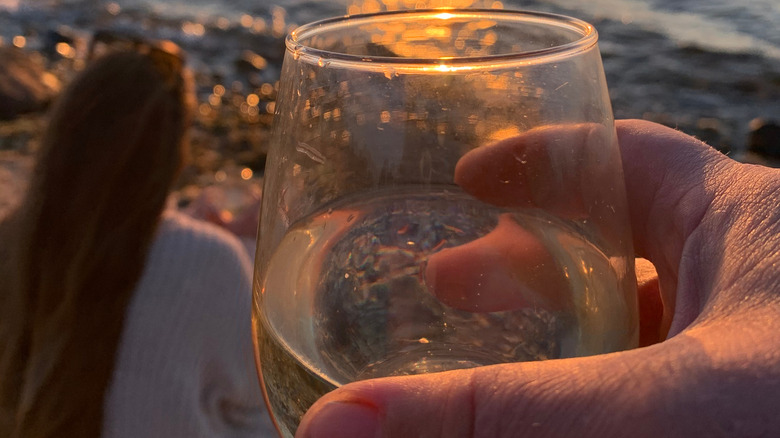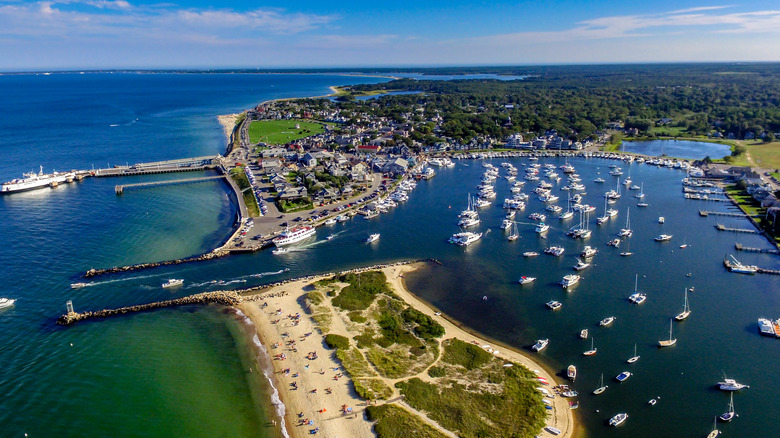Why There Are No Vineyards On Martha's Vineyard
The name Martha's Vineyard may conjure up images of sipping white wine while waves sigh against the sand and grape leaves twist through a trellis overhead. However, despite it's name, there are no actual vineyards on Martha's vineyard. Martha's Vineyard is an island seven miles off the coast of Massachusetts that is only accessible from the mainland via ferry, per the Cape Cod Chamber of Commerce. According to legend, it wasn't named because of a lost tradition of viniculture. Instead, English explorer Bartholomew Gosnold chose the second part of the name after observing the wild fox grapes growing on the island, according to Martha's Vineyard Magazine. The first part of the name was allegedly chosen for his baby daughter.
There is some debate over whether the "Martha" part of the name story is true, Martha's Vineyard Tour Guide co-owner Jim Rivard pointed out. He noted that there is no written evidence Gosnold, who built a fort on the island in 1602, had a daughter named Martha. On the other hand, there is some evidence that the island was once referred to as "Martin's Vineyard," in which case it could have been named for British explorer Martin Pring, who visited briefly in 1605, or John Martin, who captained Gosnold's ship. However, the wild grapes do still grow on the island. In addition to fox grapes, silverleaf grapes are also plentiful, according to the Vineyard Gazette.
A vineyard on the vineyard
There was, however, a nearly 40-year window of time in which Martha's Vineyard did live up to its name. In 1971, a winery called Chicama Vineyards established itself on the island, according to the Martha's Vineyard Chamber of Commerce Vineyard Blog. The family-owned business was actually the first bonded winery in all of Massachusetts, according to EnjoyMA. However, the business had to struggle against New England's weather and wildlife. One year, a hurricane nearly destroyed all of its grapes, and the vineyard had to design a system of nets and fences to keep birds and deer from gobbling up its produce.
The vineyard was started by George and Catherine Mathiesen, who moved to Martha's Vineyard with their six children, according to the Vineyard Gazette. In the first year, they planted six acres of grapes and harvested their first crop three years later. Eventually, the vineyard expanded to 50 acres and the couple grew varieties including Chenin Blanc, Viognier, and Zinfandel, according to the Vineyard Blog. They also mixed European and U.S. grape varieties, the Vineyard Gazette reported. However, the business closed its doors for good in 2008 after the couple died and their children decided to sell. "No one in the family wanted to continue the business on their own," their son Tim Mathiesen told the Vineyard Gazette.
Another name?
It's unlikely that another official vineyard will rise to take Chicama's place. The soil in Martha's Vineyard is sandy, which makes it hard to grow domesticated grapes there, according to the Vineyard Blog. And, as the Mathiesens discovered, both the weather and the deer are hostile. However, the English settlers who named Martha's Vineyard were not its first inhabitants, and so Martha's Vineyard was not the island's first or only name.
The first people arrived on the island before it was even an island, according to the Martha's Vineyard Chamber of Commerce. They walked from the mainland after the ice from the last ice age had melted but before the melting of glacier's farther north rushed in to flood what is now Massachusetts and created the islands of Martha's Vineyard and Nantucket. There is evidence of Indigenous settlements on the island dating from 2270 B.C. The Wampanoag people inhabited the island for thousands of years before Bartholomew Gosnold arrived. The Wampanoag called their home "Noepe," which means "land amid the waters, and" there are still around 300 Wampanoag people living on the island.


